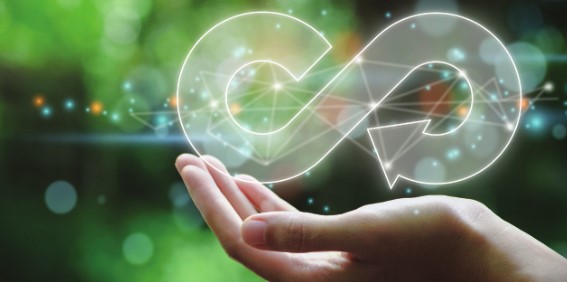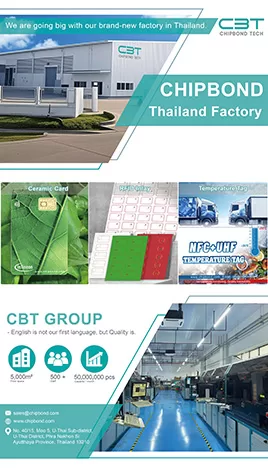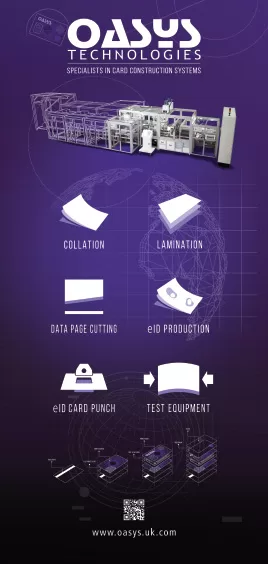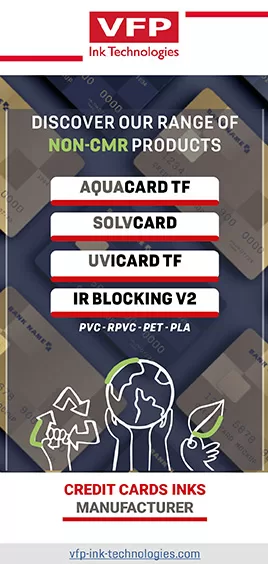
by Jennifer Kohlhepp | CM Magazine Featured
True Circular Economy: A Clean, Infinite Cycle
 By Daniel Lützelschwab, Agent, Folienwerk Wolfen GmbH
By Daniel Lützelschwab, Agent, Folienwerk Wolfen GmbH
It sounds like a vision, but it is already reality: plastic can be recycled indefinitely. This requires the elimination of toxic substances and chemical recycling. This is how we create the basis for plastics to remain continuously in the cycle.
Even at school and in the family, children today learn how important it is to conserve the earth’s natural resources. The linear economic model is clearly at odds with this endeavor. This is impressively demonstrated by Earth Overshoot Day, which marks the point in time when humanity has used up all the natural resources that the earth can provide within one year. In 2022, it fell on July 28.
With an outdated model like the linear economy, there is no way we can push back Earth Overshoot Day and relieve our planet.
The circular economy offers a more sustainable perspective for the future and has gained considerable momentum over the last decade. A true circular economy uses existing waste and reintroduces it into the cycle, including Parley Ocean Plastic®.
A Problem Becomes a Solution
The environmental protection organization Parley for the Oceans collects plastic waste from beaches and coastal regions before it enters the sea. This waste, including PET bottles, re-enters the economic cycle as a valuable raw material through mechanical recycling. In recent years, Parley Ocean Plastic® has established itself as a sustainable plastic in the bank card market. Thanks to chemical recycling, products made from Parley Ocean Plastic® can also be recycled indefinitely.
The circular economy builds on new approaches to avoid waste, recycle raw materials as often as possible and thus extend the life cycle of raw materials. The focus is on seeing and covering the entire cycle, not just parts. The cycle begins with the design and manufacture of each product and with the right choice of raw materials.
Only Pollutant-Free Materials Enable True Circularity
A truly circular economy can only be established permanently if its products and processes follow the principles of Green Chemistry.
The International Union of Pure and Applied Chemistry (IUPAC) is the globally authoritative scientific institution for chemistry-related issues. It describes green chemistry as “compliance with a set of principles.” These principles “reduce or avoid the use or generation of hazardous substances in developing, manufacturing, and using chemical products.” This definition lays the foundation for plastics that can be used without concern.
A requirement for a truly circular economy is the use of materials that are free of hazardous substances. For the plastics industry, this means, among other things, the absence of halogens and endocrine, carcinogenic, or toxic effects in the materials it uses in its raw materials and processes.
No More Toxic Accidents Thanks to Green Chemistry
In early February 2023, a freight train carrying highly toxic substances derailed in the U.S. state of Ohio. Five train wagons containing 115,000 gallons (435,300 liters) of vinyl chloride were punctured and burned for several days under uncontrolled conditions. Dioxins and related chlorinated substances formed and were released into communities surrounding the accident site. Further, four train cars carrying polyvinyl chloride plastic burned, forming dioxins. Vinyl chloride is a known human carcinogen mainly used to produce PVC plastic materials (vinyl).
Train derailments happen constantly, but without toxic cargo, no such damage exists. The accident in Ohio shows that risk management claims for toxic substances cannot be met—one more reason to rely on pollutant-free plastics that comply with the principles of green chemistry.
There Does Not Have to Be an End-of-Life Anymore
Plastics such as PET and PLA can be recycled as often as desired using chemical recycling. There is no longer a classic end in the product life cycle (end-of-life). Chemical recycling provides a secondary raw material of the highest quality, identical to petroleum-based primary plastic.
Mechanical recycling, on the other hand, which is currently still more widespread, leads to a loss of quality. It does not enable a real cycle but corresponds to a downward spiral and merely delays disposal.
Even if mechanically recycled plastic can still be used to produce waste buckets or water pipes at the end of its life, this does not solve the challenge of dispensing new plastics but passes them on to the next generation. Even today, polymers are still in use that can only be recycled mechanically. Products made from these polymers remain dependent on virgin plastics.
Chemical recycling using product-to-product methods offers enormous advantages because it eliminates waste in the recycling process and allows plastic waste to be reintroduced into the economic cycle—an infinite number of times.
Recycling methods at a glance
- Mechanical: shredding, cleaning and re-melting the plastic, resulting in an inferior secondary raw material
- Chemical: leads back to the monomer, which allows the re-synthesis of the polymer in identical quality
Only by combining both recycling methods can we reduce the amount of plastic waste that is incinerated or ends up in landfills while ensuring that as much waste as possible is recycled and turned into new materials.
Chemical Recycling is the Future
Chemical recycling is a mature and well-proven technology that holds enormous potential.
The U.S. chemical company Eastman Chemical is investing up to 1 billion U.S. dollars in a new molecular recycling plant in Normandy, France. Starting in 2026, up to 160,000 metric tons of difficult-to-recycle plastic waste that is currently incinerated will be recycled there each year.
Carbios, a pioneer in the development of enzymatic solutions dedicated to the end-of-life of plastic and textile polymers, and Indorama Ventures, the world-leading PET manufacturer, jointly announce a collaboration to build a manufacturing plant operating Carbios’ PET bio-recycling technology at Indorama Ventures’ PET production site. The plan for the reference plant is to be operational in 2025 in France (Longlaville) with a processing capacity of 50.000 tons of PET waste per year.
Polyesters are Circular Polymers
Whether colorless or colored, clean or contaminated: Polyesters such as PET and PETG are circular polymers and meet the requirements of Green Chemistry and the EU Chemicals Strategy, the central part of the European Green Deal. They are entirely halogen-free and free of toxic substances at every life cycle stage.
Polylactides are Transformed into Lactic Acid by Hydrolysis
PLA can be degraded to its basic building block, lactic acid, via hydrolysis. After appropriate processing, this lactic acid can be used again for technical processes or in the pharmaceutical, cosmetics, and food industries. It is also possible to re-polymerize the lactic acid back into PLA, which allows new PLA to be created from old PLA without any loss of quality, as with mechanical recycling.
Yes to Truly Clean Plastics
Plastics will remain indispensable in the future. But which plastics do we invest in? Only if we take Green Chemistry into account and focus on chemical recycling can we close the loop and a true circular economy can be established. Only a clean and closed loop will make it possible to stop using new plastics. Let’s take responsibility together and do our part to solve the plastic challenge for future generations. Let’s say yes to truly clean plastics.
About the Author: Daniel Lützelschwab is an agent for Folienwerk Wolfen GmbH.






